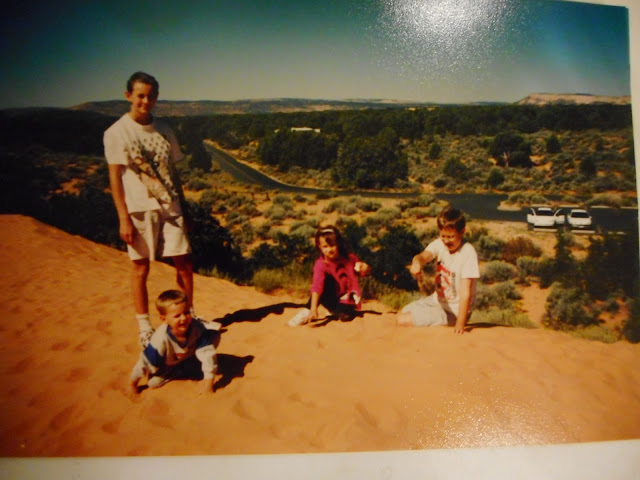A 1998 photograph of the Coral Pink Sand Dunes/
THE Coral Pink Sand Dunes is truly Utah’s mini version of the Sahara Desert.
Decades
before Little Sahara Recreation Area, Coral Pink gained world-wide fame through
Hollywood by actually depicting the Sahara Desert in movies as early as 1943 –
all this without “Sahara” in Coral Pink’s name.
“Movie Company awaits approach of spring to resume filming ‘Battle of Africa” was a January 1, 1943 headline in the Salt Lake Tribune.
(Battle of
Africa was a just a part of the movie being filmed at Coral Pink. The film was
actually titled “Sahara.”)
In 1942, the State of Utah had constructed the first road off Highway 89 into the Coral Pink area. Hollywood was eager to showcase Utah’s colorful, sandy area.
Kids playing at Coral Pink Sand Dunes.“At any
rate, coral pink sand dunes of southern Utah are a pride and joy of Hollywood
producers,” the Tribune story stated.
Coral Pink
was designated as a state park 20 years later, in 1963. It is located 27 miles
northwest of Kanab in Kane County. It comprises 3,730 acres, including some
2,000 acres that are wholly sand.
(In
contrast, central Utah’s Little Sahara Recreation Area, though much larger, at
60,000 acres, was not developed until 1976 and lacks such colorful sand.)
-During
Utah’s Centennial of 1947, Kanab was often referred to as “Utah’s Hollywood.”
Indeed, the
Piute County News of Junction, Utah, published a widely distributed graphic for
the Centennial by the State of Utah that stated on June 6, 1947, “Everybody in
Kanab, Garfield County, is a potential movie actor, when film companies come to
use the scenic grandeur of the southern Utah country for location of movie
westerns. Even businessmen close up shop to act as extras.”
(However, eventually Hollywood crews began bringing with them armies of personnel, including cowboys, for their movies, leaving most of Kanab’s 1,500 residents without much of a chance at movie work.)
-Harry
Sherman, a Hollywood producer, chose the Zion National Park and Kanab area for
scenes in a new movie, “Ramrod” in 1947.
-How capable
were some of the Hollywood actors that portrayed cowboys in actual cowboy
skills? Some were really good.
“Hollywood turns actor to cowboy” was a November 16, 1942 headline in
the Ogden Standard-Examiner. The story reported that actors Glenn Ford and Big Boy
Williams were in Kanab filming “The Desperadoes” movie, in the summer prior, and
they decided to enter a local Kanab rodeo during their off time, The two actors
ended up winning the “rescue race” event at the rodeo, proving some real-life
rodeo skills.
-MORE
HISTORY: The 64-mile road from Kanab, Utah to Page, Arizona was primarily
constructed in the late 1950s, in conjunction with the Glen Canyon Dam project.
However, this highway wasn’t always Highway 89. According to the Salt Lake
Tribune on August 2, 1959, the highway’s original designation was U-259 on the
Utah road section and highway number 189 in Arizona. It was on August 1, 1959
when road crews in both states began using U.S. 89 as the highway’s consistent title.
At the same time, the former Highway 89 road from Kanab south to Bitter Springs
in Arizona was re-designated as Alternative U.S. 89.


No comments:
Post a Comment